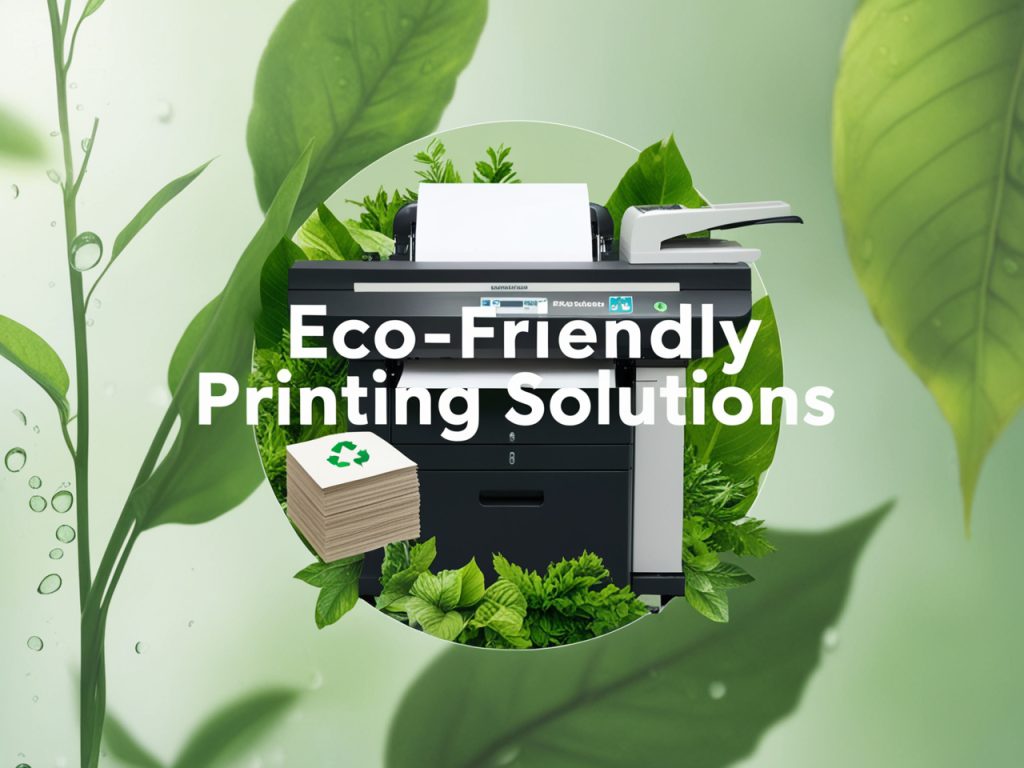
As environmental concerns continue to grow, businesses and consumers alike are seeking more sustainable options for everyday activities—including printing. Eco-friendly printing solutions are designed to reduce the environmental impact of traditional printing processes by utilizing sustainable materials, energy-efficient technologies, and waste-reduction practices. Whether you’re a business looking to minimize your carbon footprint or an individual aiming for greener practices, eco-friendly printing offers various ways to achieve these goals.
This guide explores the importance of eco-friendly printing, available solutions, and best practices for making your print projects more sustainable.
1. Why Choose Eco-Friendly Printing? #
Eco-friendly printing solutions help reduce the environmental impact associated with traditional printing processes. Here’s why making the switch is essential:
1.1 Reduced Waste #
- Traditional Printing: Standard printing methods often result in excessive paper waste due to overprinting, mistakes, or inefficient use of materials.
- Eco-Friendly Printing: By using recycled paper, on-demand printing, and digital technologies, businesses can reduce the amount of waste generated.
1.2 Lower Carbon Footprint #
- Traditional Printing: The production of paper, inks, and other materials can have a significant environmental impact, contributing to deforestation, air pollution, and water waste.
- Eco-Friendly Printing: Sustainable printing uses energy-efficient processes and renewable resources, resulting in a lower carbon footprint.
1.3 Healthier Materials #
- Traditional Printing: Many conventional inks and coatings contain harmful chemicals that can be toxic to the environment and human health.
- Eco-Friendly Printing: Eco-friendly printing uses non-toxic, vegetable-based inks, and water-based coatings that are safer for both the planet and consumers.
2. Eco-Friendly Printing Solutions #
Here are some of the most effective eco-friendly printing solutions available today:
2.1 Recycled and FSC-Certified Paper #
Recycled paper is made from post-consumer waste, which helps reduce deforestation and the demand for virgin paper production. Alternatively, FSC-certified paper is sourced from responsibly managed forests, ensuring that the paper you use supports sustainable forestry practices.
- Benefits: Reduces the need for new raw materials, conserves forests, and lowers the environmental impact of paper production.
- Best For: Business cards, brochures, flyers, posters, and packaging.
2.2 Vegetable-Based and Soy-Based Inks #
Traditional inks are often petroleum-based, which releases volatile organic compounds (VOCs) into the atmosphere, contributing to air pollution. Vegetable-based inks, particularly soy-based inks, are a more sustainable alternative. They are derived from renewable resources and produce less VOCs, making them less harmful to the environment.
- Benefits: Lower environmental impact, less toxic, and offers vibrant color quality.
- Best For: Eco-friendly brochures, packaging, and business cards that require high-quality colors.
2.3 Waterless Printing #
Waterless printing is an advanced offset printing technology that eliminates the need for water during the printing process. Traditional printing methods use water to keep the printing plate clean, but this can result in significant water waste and contamination from chemicals. Waterless printing uses silicone plates, which don’t require water for cleaning.
- Benefits: Reduces water waste and eliminates chemical runoff, resulting in a cleaner, more efficient process.
- Best For: High-volume print runs where sustainability and precision are critical, such as brochures, magazines, and catalogs.
2.4 Digital Printing #
Digital printing is a highly efficient and eco-friendly alternative to traditional offset printing. It eliminates the need for printing plates and reduces waste by printing only the exact number of copies needed. Digital printing is ideal for short print runs and on-demand printing, reducing overproduction and resource consumption.
- Benefits: Minimal setup waste, energy-efficient, and eliminates the need for large print runs.
- Best For: On-demand printing for business cards, marketing materials, posters, and personalized prints.
2.5 On-Demand Printing #
On-demand printing ensures that you print only what you need, when you need it, which reduces the risk of overproduction and waste. This approach is particularly effective for short print runs, where traditional offset printing would result in more waste.
- Benefits: Reduced waste, no need for storage, and lower costs for small batches.
- Best For: Event materials, promotional products, and business documents that require frequent updates.
2.6 Biodegradable and Recyclable Materials #
For packaging, promotional items, and labels, you can opt for biodegradable or recyclable materials. Biodegradable materials break down naturally over time, while recyclable materials can be processed and reused to create new products, reducing landfill waste.
- Benefits: Reduces landfill waste and pollution, and supports a circular economy.
- Best For: Product packaging, event materials, and labels.
3. Sustainable Printing Practices #
In addition to using eco-friendly materials and processes, adopting certain best practices can make your printing projects more sustainable:
3.1 Optimize Print Design #
- What It Is: Design your print materials with sustainability in mind by minimizing the amount of ink used and optimizing layout to reduce paper waste.
- How to Do It: Use eco-friendly fonts, limit the use of full-bleed designs (which can waste paper), and keep design elements simple to reduce ink consumption.
- Best For: Business cards, brochures, and flyers that require frequent printing.
3.2 Use Eco-Friendly Finishing Options #
- What It Is: Finishing options like laminates, foils, and coatings often involve harmful chemicals and materials. Choose water-based coatings, recycled laminates, or opt for no finishing at all to minimize environmental impact.
- Best For: Premium products like business cards, brochures, and packaging.
3.3 Choose Local Printers #
- What It Is: Working with local printers reduces the transportation-related carbon emissions associated with shipping printed materials over long distances.
- How to Do It: Choose a nearby printing company that offers eco-friendly practices, or inquire if your existing printer offers sustainable solutions.
- Best For: Brochures, flyers, and business documents that need to be distributed locally.
3.4 Print in Bulk (When Necessary) #
- What It Is: For large orders, printing in bulk reduces the energy consumption of multiple small print runs. This can be more eco-friendly if you know you’ll need a large volume of materials.
- How to Do It: Plan ahead for marketing campaigns or product launches to avoid last-minute small runs.
- Best For: High-volume materials like catalogs, posters, and product labels.
4. How to Choose the Right Eco-Friendly Printing Solution for Your Project #
To select the right eco-friendly printing solution, consider the following:
4.1 The Purpose of Your Print Project #
- Promotional Materials: For brochures, flyers, or banners, consider using recycled paper and vegetable-based inks to reduce your environmental impact.
- Packaging: For product packaging, opt for biodegradable or recyclable materials to minimize waste and pollution.
- On-Demand Printing: If you need flexibility, digital printing allows for on-demand prints, reducing unnecessary waste.
4.2 Volume of Your Print Run #
- Short Print Runs: If you only need a few copies, digital printing and on-demand services are more eco-friendly and cost-effective.
- Large Print Runs: For large quantities, waterless printing or bulk offset printing on recycled paper may offer the best balance of sustainability and cost savings.
4.3 Budget Considerations #
While eco-friendly printing solutions are increasingly cost-effective, some materials (like FSC-certified paper or vegetable-based inks) may carry higher upfront costs. However, the long-term benefits to the environment and your brand’s sustainability initiatives can outweigh these costs.
5. Certifications to Look for in Eco-Friendly Printing #
When choosing eco-friendly printing services, look for these certifications that ensure sustainable practices:
FSC (Forest Stewardship Council) Certification #
- What It Means: The paper comes from responsibly managed forests that provide environmental, social, and economic benefits.
SFI (Sustainable Forestry Initiative) Certification #
- What It Means: Ensures the use of sustainable forestry practices for the production of paper products.
Green Seal Certification #
- What It Means: Products and services that meet strict sustainability standards in the printing and graphic arts industry.
Carbon Neutral Certification #
- What It Means: Printers that offset their carbon emissions through renewable energy projects or reforestation efforts.
6. Benefits of Eco-Friendly Printing for Your Brand #
Opting for eco-friendly printing doesn’t just benefit the environment; it can also enhance your brand’s reputation. Consumers are increasingly drawn to companies that demonstrate a commitment to sustainability.
1. Positive Brand Image #
Using eco-friendly printing solutions allows you to align your brand with environmental values, appealing to eco-conscious customers and stakeholders.
2. Competitive Advantage #
As more businesses shift towards sustainable practices, eco-friendly printing can differentiate your brand from competitors who haven’t made the change.
3. Consumer Trust and Loyalty #
Consumers are more likely to trust and remain loyal to brands that demonstrate social responsibility and environmental stewardship.
Conclusion #
Eco-friendly printing solutions offer a wide range of options for businesses and individuals looking to reduce their environmental impact without sacrificing quality. From using recycled paper and vegetable-based inks to adopting digital and waterless printing methods, sustainable printing practices can benefit both the environment and your brand’s reputation. By making conscious choices about the materials, methods, and suppliers you use, you can create high-quality, eco-friendly printed materials that reflect your commitment to a greener future.
You can find free business card templates on Freepik.
Learn more about the different printing methods in this comprehensive guide.

